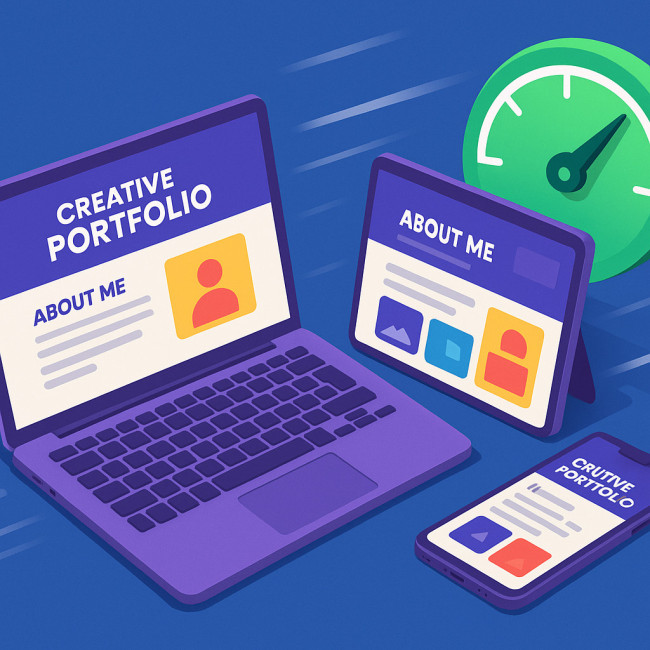Launch checklist 2025: security, analytics and promo steps for a new portfolio
Getting a brand-new portfolio online in 2025 means more than hitting “publish”. You need airtight security, rock-solid analytics and a promotion plan that attracts recruiters from day one. Follow this step-by-step launch checklist to protect your work, track every visitor action and generate buzz that converts.
1. Secure your foundation before a single pixel loads
1.1 Switch to HTTPS + HSTS
Browsers now flag non-HTTPS sites as “Not secure”. Buy a TLS certificate or use a free Let's Encrypt option, then enforce HTTP Strict Transport Security (HSTS) to block downgrade attacks. Bonus: Google rewards HTTPS with a small ranking boost.
1.2 Harden your CMS and hosting
- Remove default “admin” usernames and create complex 15-character logins.
- Install a web-application firewall (WAF) such as Cloudflare or Sucuri.
- Limit login attempts to three tries and enable 2-factor authentication.
- Delete unused themes, plugins and demo content—each line of code is a potential exploit.
1.3 Automate backups and uptime monitoring
Schedule daily off-site backups and store a weekly image in cold storage (e.g., Amazon S3 Glacier). Pair this with a 30-second uptime monitor so you receive instant alerts if hackers or hosting issues take your site offline.
2. Configure analytics before going public
2.1 Deploy Google Tag Manager and GA4
Create one container per domain and publish it to a staging URL first. In GA4, set up events for:
- Portfolio page views (auto-captured).
- Clicks on Hire me buttons.
- Play events on showreels.
- Outbound link clicks to social channels.
These events will power conversion reports that show which pieces trigger contact attempts.
2.2 Map a measurement plan
| Goal | Primary KPI | Alert threshold |
|---|---|---|
| Recruiter enquiries | 5 per week | < 3 per week |
| Showreel engagement | 50 % completion rate | < 30 % |
| Newsletter sign-ups | 10 per week | < 5 per week |
2.3 Stay privacy-compliant
Add a consent banner that fires GA4 only after acceptance. Store user preferences in a first-party cookie for six months. This keeps you aligned with GDPR and upcoming ePrivacy rules.
3. Performance tweaks that protect retention

Speed is a security and UX win. Compress every image under 300 kB and serve next-gen formats like WebP. For deeper guidance, review our article on optimising your images so recruiters never bounce from your site. Beyond compression, activate HTTP/2 or HTTP/3, enable server-side caching and inline only the critical CSS to paint above-the-fold content in under 2 seconds. Defer non-essential JavaScript, sprinkle lazy-loading on below-the-fold visuals and preload hero assets to shorten the perceived wait. These micro-optimisations shave hundreds of milliseconds, which directly correlate with engagement and conversion rates: every extra second costs roughly 11 % of page views. Recruiters skimming portfolios on hotel Wi-Fi during a conference will notice the near-instant interactivity and perceive your craft as equally meticulous. A lean, lightning-fast bundle also reduces energy consumption, giving you an eco-friendly talking point when pitching sustainability-minded clients.
Source : Google/SOASTA Research
Once the site loads in under two seconds, reinforce storytelling. Small tweaks—contrast hierarchy, scannable captions—can boost engagement. Dive into visual storytelling tweaks for inspiration.
4. Launch-day promotion roadmap
4.1 Warm up your existing network
Send a short “sneak-peek” email 24 hours before launch. Include one hero image, a CTA and a calendar invite for an optional live walkthrough. Early traffic primes GA4 with valuable behavioural data.
4.2 Cross-post to specialist directories
Upload your strongest hero shot to three platforms relevant to your craft, then link back. For example, new-portfolio spotlights on Artfolio regularly drive scouts to emerging profiles.
4.3 Earned media and backlinks
- Pitch a behind-the-scenes article to a niche publication—include your unique workflow or sustainability angle.
- Offer a free mini-course or webinar; list it on Eventbrite and community Slack channels.
- Guest on a podcast to discuss portfolio trends and mention your URL in the show notes.
Complement these tactics with quick SEO wins to amplify organic visibility.
5. Post-launch optimisation sprint (first 30 days)
5.1 Review KPI dashboards every Monday
Look at traffic sources, enquiry conversions and scroll depth. If a gallery receives high impressions but low clicks, re-order thumbnails or add a short caption.
5.2 A/B test your hero section
Create two versions: one static image vs. an autoplay muted reel. Run each for one week with equal traffic. Keep the version that grows time on page and enquiry clicks.
5.3 Schedule micro-content refreshes
Add one new project per month and retire the lowest-performing piece. This keeps the algorithm (and recruiters) returning. Use GA4's Exploration report or interpret your traffic data to guide the curation.
Quiz: Ready for lift-off?
FAQ
- How often should I back up my portfolio site?
- Daily incremental backups plus one full weekly backup stored off-site are industry best practice.
- When should I submit my sitemap to search engines?
- Immediately after launch—ideally the same day you push the live version and verify ownership in Search Console.
- What's a safe number of plugins to run?
- Only those you actively use. For most creatives, 10 well-maintained plugins or fewer keeps attack surfaces small.
- Which metrics matter most in the first month?
- Unique visitors, enquiry conversions, showreel completion rate and average load time.
- Do I need a CDN for a portfolio with small traffic?
- Yes if your audience is global. A free tier CDN reduces latency and adds an extra DDoS protection layer.
Ready to roll? Download the printable checklist and keep it near your desk on launch day.











